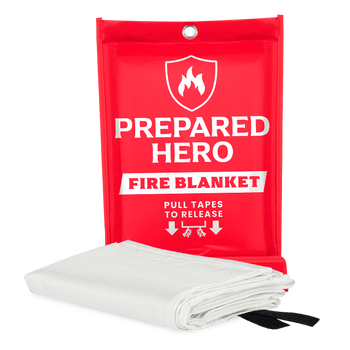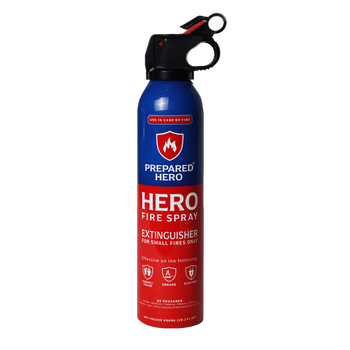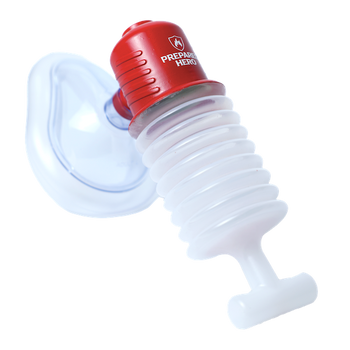Where you put your smoke detectors matters just as much as installing them. Proper placement makes sure they can detect...
A fire blanket works by smothering the fire and depleting it of oxygen. Since it’s fire-resistant, it can withstand high temperatures without burning. This gives it enough time to get rid of the oxygen. Since fire can’t continue burning without oxygen, it eventually dies.
While a fire blanket is handy for putting out a fire without the mess, it might not be the best option sometimes. But if you don’t know where to start, we’re here to help. In this article, we’ll talk about the advantages and disadvantages of a fire blanket so you can make an informed decision.
What Are the Advantages of a Fire Blanket?
A fire blanket is designed to prevent small fires from turning into a huge, hot mess. But what exactly are the advantages of a fire blanket? Find out below:
Lightweight

Fire blankets are usually made of fiberglass and protective silicone coatings, which are fire-resistant and lightweight. On the other hand, a fire extinguisher is heavy, making it hard for the elderly and kids to use. Specifically, a fire extinguisher usually weighs five to ten pounds, while a fire blanket weighs one to two pounds.
No Mess

Fire blankets like the Hero Fire Blanket don’t leave a mess after use. On the other hand, fire extinguishers leave a mess that needs to be cleaned up. Some fire extinguishers also leave toxic chemicals that can clog pipes and cause mild skin irritation, moderate eye irritation, and potential gastric distress.
But if you only have a fire extinguisher, choose the mess over the fire. Here’s a guide on how to clean up after using a fire extinguisher.
Helps Someone on Fire

You can’t use a fire extinguisher to help someone on fire. Fire extinguishers have toxic chemicals that can irritate your skin and harm your respiratory system. Inhaling their fumes lets toxins enter your bloodstream and irritate your lungs. In more serious cases, such toxins can cause heart issues.
A fire blanket doesn’t endanger people like this. You can safely use a fire blanket to save someone on fire. Simply wrap the person with it. Cover everything on fire, and use multiple fire blankets if needed. You can also use fire blankets to protect yourself and your loved ones from fire as you evacuate your house.
Easy to Use

You only need to cover a fire with a fire blanket. Since it’s lightweight, you can quickly grab it and throw it over the fire. On the other hand, fire extinguishers require extra steps.
Fire extinguishers are harder to use than fire blankets. They call for training and familiarization with the PASS (pull, aim, squeeze, and aim) technique. In addition, many people can’t pull the safety pins during a fire emergency due to panic.
Fire blankets are always ready to use since they don’t have contents, locking pins, or working mechanisms that make them difficult to handle. Even the elderly and children can use fire blankets. Check out this guide to teaching your kids how to use a fire blanket for more information.
No Expiry

Fire extinguishers expire, while fire blankets usually don’t. You can also reuse a fire blanket as long as it’s not damaged. Check out how many times you can use a fire blanket before replacing it here.
Plus, a fire blanket can last for many years with low maintenance, and brands like Prepared Hero offer fire blankets that never expire. On the flip side, expired fire extinguishers are not safe to use because they’re prone to chemical breakdown, leaks, corrosion, and reduced spray range. If you have one at home, learn when to replace your fire extinguisher here.
Low Maintenance

Fire blankets don’t require regular maintenance or refills. You can take care of your fire blanket while spending less. Just wipe it after use, inspect it for damage, and store it away from moisture and direct sunlight. Replace it if you see any damage. It may seem like an investment, but the cost is just a fraction of buying a fire extinguisher and maintaining or refilling it.
Non-Toxic

Unlike fire extinguishers, fire blankets are non-toxic. Modern fire blankets are made of safe, fire-resistant materials like fiberglass, aramid fibers, and silicone.
On the other hand, fire extinguishers contain chemicals that are toxic even to healthy people when inhaled. These toxic chemicals are also not good for the environment. Hence, a fire blanket is a more eco-friendly option without health risks.
Easy to Store

Fire extinguishers are bulky, so you need space for them. They also require specialized storage equipment like glass cases, metal stands, and cabinets. Fire blankets barely take up space. You can just hang them on the wall using fire blanket hooks.
Can Be Used on Grease Fires

Not many know this, but water-based fire extinguishers can make fires worse. In fact, you should never use water to put out a grease fire. Water and oil don’t mix, and since water is denser, it will go to the bottom of the pan and push the oil out. Oil will splatter everywhere and might explode.
This is where a fire blanket comes in. Covering the grease fire with it prevents oil from splashing and protects you from injuries.
What Are the Disadvantages of a Fire Blanket?
While fire blankets are effective against most types of fires, they may not sometimes be the best choice. Knowing the limitations of fire blankets and when not to use them is a must. Here are the disadvantages of a fire blanket:
Can’t Be Used on Large, Fast-Growing Fires

Fire blankets are designed to put out small fires. They work by covering the fire to deprive it of oxygen. Since oxygen is a component of the fire triangle, the fire eventually dies. However, this will only work if the fire blanket completely covers the fire. Given this, you can’t use a fire blanket if the fire is bigger than it.
It’s also not safe to use it on fast-growing fires. Based on the Department of Homeland Security, a small flame can turn into a major fire in as fast as 30 seconds. Fire can spread quickly, and once it does, you can’t cover everything with a fire blanket at once.
Can’t Be Used When the Power Source Is On

Let’s set the record straight: you can safely use fire blankets on electrical fires only if the power source is off. While fire blankets don’t conduct electricity, there’s still a chance of electrocution and injuries.
Using a fire blanket on an electrical fire when the power source is on might reignite the fire. Electrical fires involve circuit boards and wires that might spark after the fire dies.
Can’t Be Used on Accelerant and Toxic Gas Fires

We also don’t recommend using fire blankets on fires fueled by accelerants like diesel and gasoline. They’re extremely flammable and cause fast-spreading fires that a fire blanket can’t completely cover. Accelerants can also seep into surfaces. As a result, they reignite the fire. It’s better to use a fire spray or extinguisher made for flammable liquids in this case.
In addition, we don’t recommend using a fire blanket on toxic gas fires. A fire blanket can’t fully filter smoke, so it can’t contain toxic gases. The gases might cause difficulty breathing, trigger asthma attacks, and cause other respiratory issues. The last thing you want during a fire is to become unconscious.
Some chemicals also react violently when covered or disturbed, so it’s safer not to use a fire blanket. Unless you’re trained to put out toxic chemical fires, get out and call 911 immediately.
Can’t Be Used on Metal Fires

While fire blankets can put out small metal fires, we don’t recommend using them on fires caused by metals with high ignition temperatures. For instance, if your fire blanket can handle temperatures up to 700°C, you should not use it to put out a metal fire with an ignition temperature of more than 700°C. In addition, combustible metals like aluminum, zinc, and potassium can ignite and burn intensely. In this case, you need a fire extinguisher made for metal fires.
Conclusion
Fire blankets are handy for putting out small fires and saving someone on fire. They’re also lightweight, easy to use, and don’t leave a mess behind. But sometimes, they have disadvantages that we shouldn’t ignore. If a fire is getting out of control or involves metals, accelerants, and toxic gases, a fire blanket isn’t the best tool for the job. Understanding these limits helps you make informed decisions. Stay safe, hero!


 Fire
Fire Safety
Safety Survival
Survival Protection
Protection New
New
 Fire
Fire Safety
Safety Survival
Survival Protection
Protection New
New












